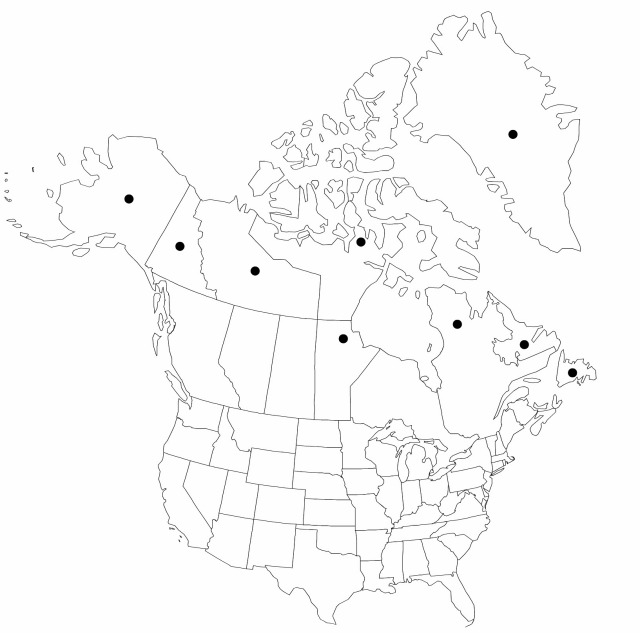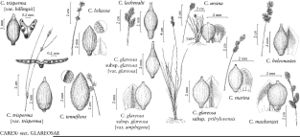Difference between revisions of "Carex marina"
Amer. J. Sci. Arts 29: 247, plate X, fig. 74. 1836.
FNA>Volume Importer |
FNA>Volume Importer |
||
| Line 27: | Line 27: | ||
|elevation=0–200 m | |elevation=0–200 m | ||
|distribution=Greenland;Man.;Nfld. and Labr.;N.W.T.;Nunavut;Que.;Yukon;Alaska;Europe (Spitsbergen Island;Norway;Vajgac Island;Russia). | |distribution=Greenland;Man.;Nfld. and Labr.;N.W.T.;Nunavut;Que.;Yukon;Alaska;Europe (Spitsbergen Island;Norway;Vajgac Island;Russia). | ||
| − | |discussion=<p>Plants from Greenland and Europe often with two spikes and short-beaked perigynia have been called Carex marina subsp. pseudolagopina (Sörensen) Böcher; subsp. marina from North America and Siberia differs in having usually (2–)3(–4) spikes usually equal in size (the terminal spike not larger than the others), narrower leaves, and a more distinct beak. Both types occur in the North American material, subsp. pseudolagopina tends to be more arctic in distribution. The subspecies are not recognized here as separate taxa.</p> | + | |discussion=<p>Plants from Greenland and Europe often with two spikes and short-beaked perigynia have been called <i>Carex marina</i> subsp. pseudolagopina (Sörensen) Böcher; subsp. marina from North America and Siberia differs in having usually (2–)3(–4) spikes usually equal in size (the terminal spike not larger than the others), narrower leaves, and a more distinct beak. Both types occur in the North American material, subsp. pseudolagopina tends to be more arctic in distribution. The subspecies are not recognized here as separate taxa.</p> |
|tables= | |tables= | ||
|references= | |references= | ||
| Line 51: | Line 51: | ||
|publication year=1836 | |publication year=1836 | ||
|special status= | |special status= | ||
| − | |source xml=https://jpend@bitbucket.org/aafc-mbb/fna-data-curation.git/src/ | + | |source xml=https://jpend@bitbucket.org/aafc-mbb/fna-data-curation.git/src/8f726806613d60c220dc4493de13607dd3150896/coarse_grained_fna_xml/V23/V23_555.xml |
|genus=Carex | |genus=Carex | ||
|section=Carex sect. Glareosae | |section=Carex sect. Glareosae | ||
Revision as of 16:09, 18 September 2019
Plants loosely cespitose, in small clumps; rhizomes short. Culms erect, slender, 10–15(–30) cm, rough distally. Leaves: sheaths pale brown abaxially, persisting, inner band thin, hyaline, sometimes red tinged, truncate or shallowly concave at summit; ligules shorter than wide; blades pale green to gray-green, flat or slightly involute, 5–10 cm × 1–2 mm, shorter than culms. Inflorescences 0.7–1.5 cm × 4–7 mm; proximal bracts scalelike, occasionally bristlelike, shorter than spikes. Spikes 2–3(–4), lateral spikes gynecandrous, closely approximate or the proximal slightly separate, individually distinct, containing 3–8 perigynia, oblong-clavate, 3–6 × 3–5 mm; terminal spike not clavate. Pistillate scales red-brown with lighter center and broad white-hyaline margins oblong-ovate, subequal to perigynia, apex obtuse. Perigynia appressed-ascending, green-white proximally, pale brown distally, often brown in age, finely several-veined, elliptic, 2–3 × 1.25–1.5 mm, widest near middle, apex conic with weakly convex, usually entire margin, subcoriaceous; beak indistinct. Achenes red-brown, broadly obovate, 1.25–1.5 × 1 mm, dull to slightly glossy. 2n = 62, 64.
Phenology: Fruiting Jul–Aug.
Habitat: Boggy tundra, gravelly shores
Elevation: 0–200 m
Distribution

Greenland, Man., Nfld. and Labr., N.W.T., Nunavut, Que., Yukon, Alaska, Europe (Spitsbergen Island, Norway, Vajgac Island, Russia).
Discussion
Plants from Greenland and Europe often with two spikes and short-beaked perigynia have been called Carex marina subsp. pseudolagopina (Sörensen) Böcher; subsp. marina from North America and Siberia differs in having usually (2–)3(–4) spikes usually equal in size (the terminal spike not larger than the others), narrower leaves, and a more distinct beak. Both types occur in the North American material, subsp. pseudolagopina tends to be more arctic in distribution. The subspecies are not recognized here as separate taxa.
Selected References
None.
